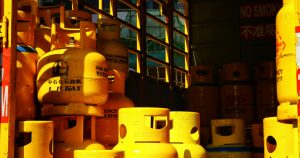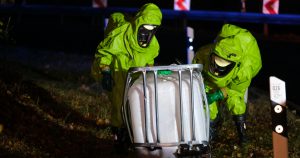Every day, workers across industries transfer hazardous liquids and chemicals using methods that expose them to serious risks. From pharmaceutical laboratories to chemical manufacturing plants, the simple act of moving liquid from one container to another creates hazards that many organisations underestimate—until an incident occurs.
Understanding these risks is the first step toward implementing safer practices that protect your workforce, reduce liability, and maintain regulatory compliance.
The Scale of the Problem
Transferring hazardous liquids is one of the most common—and most dangerous—tasks in facilities handling chemicals. Whether decanting from drums into process equipment, sampling from containers, or moving materials between locations, each transfer creates opportunities for exposure.
Consider the typical scenario: a worker needs to transfer a corrosive liquid from a 205-litre drum into a smaller vessel. Using traditional methods, they might tilt the drum, use a pump with open connections, or manually pour the liquid. Each approach creates distinct hazards that put the operator at risk.
Chemical Exposure Pathways
Traditional transfer methods create multiple routes for chemical exposure:
Skin contact occurs through splashes during equipment connection or disconnection, drips when moving hoses or tubes, spills from overfilling or improper sealing, and residue on containers, valves, or equipment surfaces. Even brief skin contact with corrosive, toxic, or sensitising substances can cause serious harm. Some chemicals cause immediate burns, while others create long-term health effects from repeated low-level exposure.
Inhalation hazards arise when vapours escape during transfer operations. Opening containers releases trapped vapours, while liquid movement creates aerosols and mists. Many hazardous liquids have vapour pressures high enough that significant airborne concentrations develop quickly in confined spaces. Toxic vapours can cause acute effects—from irritation to unconsciousness—while some chemicals create chronic health impacts from repeated inhalation exposure.
Ingestion risks, though less common, occur when contaminated hands touch faces or food, aerosols settle on surfaces where eating or drinking occurs, or improper cleanup leaves residues. Even small ingested amounts of certain chemicals can cause serious harm.
Specific Hazards of Traditional Methods
Manual Pouring
Pouring chemicals directly from containers may seem simple, but it creates numerous hazards. The liquid stream can create splashes on impact, static electricity can build up during pouring (particularly with flammable solvents), and workers must lean over containers, bringing their faces close to vapours. Controlling flow is difficult, leading to spills from overfilling or splashing from pouring too quickly.
Open Pumping Systems
Pump systems with unsealed connections expose workers during setup and breakdown. Connecting hoses to container openings releases vapours, disconnecting equipment drips residual chemical, and leaks at connection points create exposure throughout the transfer. Many pump systems require workers to monitor the receiving container, keeping them in proximity to vapours and spill risks.
Tilting and Siphoning
Some operations tilt drums or containers to pour chemicals, creating ergonomic hazards from manual handling and chemical exposure risks from splashing and vapour release. Siphoning using mouth suction (still occasionally seen despite obvious dangers) creates immediate ingestion and inhalation risks. In contrast, even mechanical siphons often require opening containers and monitoring tube positions.
Container Handling
Moving containers of hazardous liquids creates additional risks beyond the transfer itself. Lifting, tilting, or manipulating heavy drums can cause musculoskeletal injuries, while rough handling increases the likelihood of splashes and spills. Damaged containers may leak unexpectedly, and residual chemicals on container exteriors contaminate gloves and surfaces.
Secondary Hazards
Beyond direct chemical exposure, traditional transfer methods create additional risks:
Cross-contamination occurs when equipment used for multiple chemicals isn’t properly cleaned between uses. Trace amounts of one chemical mixing with another can create unexpected reactions, alter product quality, or introduce contaminants into sensitive processes.
Environmental release happens when spills reach drains, floor cracks, or ventilation systems. Even small amounts of certain chemicals can create environmental compliance issues or compromise facility operations.
Fire and explosion risks are present during the transfer of flammable liquids. Static electricity generation, ignition sources near vapours, or spills reaching hot surfaces can trigger fires. Poor ventilation allows flammable vapours to accumulate, creating explosion hazards.
Waste generated by traditional methods often exceeds the necessary amount. Absorbent materials used for spill cleanup, contaminated PPE requiring disposal, rinsing solutions from equipment cleaning, and residual chemicals in containers all create hazardous waste streams.
The PPE Limitation
Organisations often rely on personal protective equipment (PPE) as the primary form of protection during chemical transfer. While PPE is essential, it has significant limitations:
PPE can fail through chemical breakthrough, physical damage, or improper fit. Donning and doffing create contamination risks when workers remove gloves or protective clothing. Comfort issues with extensive PPE lead to reduced compliance, particularly during repetitive tasks. Most importantly, PPE is the last line of defence—it mitigates harm after exposure occurs rather than preventing exposure entirely.
Regulatory and Liability Considerations
Health and safety regulations increasingly emphasise hazard elimination and substitution over PPE-based protection. Under the Control of Substances Hazardous to Health (COSHH) Regulations, employers must prevent or adequately control exposure to hazardous substances. Traditional transfer methods that rely primarily on PPE may not satisfy “adequately control” requirements when engineering controls are available.
Beyond regulatory compliance, organisations face liability from workplace injuries and illnesses. Chemical exposure incidents can result in compensation claims, regulatory enforcement actions, increased insurance premiums, and reputational damage affecting recruitment and customer relationships.
The Cost of Incidents
Chemical exposure incidents carry substantial direct and indirect costs. Direct costs include medical treatment and rehabilitation, compensation payments, and regulatory fines. Indirect costs often exceed direct expenses and include production downtime during incident response, investigation, time-consuming management resources, replacement costs for damaged equipment or contaminated materials, increased insurance premiums, and reduced productivity from injured workers or temporary replacements.
Perhaps most significant are the human costs—suffering of affected workers, psychological impact on witnesses, and damage to workplace morale and safety culture. These impacts, while difficult to quantify, create lasting organisational harm.
The Engineering Control Solution
Modern approaches to chemical transfer emphasise engineering controls that eliminate exposure rather than simply managing it. Enclosed transfer systems create physical barriers between workers and chemicals, sealed connections prevent vapour escape and spill risks, and integrated fume extraction captures any vapours generated during transfer.
The LIQUISAFE system exemplifies this approach. By suspending the transfer unit above the container and using retractable dip pipes, it eliminates direct worker contact with chemicals. The sealed system extracts fumes through integrated ventilation, while the controlled operation prevents spills and splashes. Workers operate the system through external controls, maintaining distance from the chemical throughout the transfer process.
Assessing Your Transfer Operations
Organisations should evaluate their chemical transfer operations against several criteria:
How frequently are chemicals transferred? High-frequency operations warrant greater investment in engineering controls to address cumulative exposure risk.
What chemicals are being transferred? More hazardous substances—particularly toxic, very toxic, corrosive, or sensitising materials—require the highest level of protection.
What volumes are involved? Larger transfer volumes increase spill consequences and exposure duration.
What’s the current incident rate? Even near-misses indicate that existing controls are inadequate.
How reliable is PPE compliance? If workers resist wearing full protective equipment due to comfort or convenience, exposure is occurring.
Making the Change
Transitioning from traditional transfer methods to enclosed systems requires planning but delivers immediate benefits. Organisations should prioritise transfers involving the most hazardous materials, the highest frequency operations, and those where current methods show the highest incident rates.
Implementation includes training workers on new equipment, establishing maintenance and cleaning procedures, and integrating systems with existing fume-extraction infrastructure. Most organisations find that improved safety, reduced incident costs, and better regulatory compliance justify the investment quickly.
Protecting Your Most Valuable Asset
Your workforce is your most valuable asset. Traditional chemical transfer methods put workers at unnecessary risk every day. While these methods may have been acceptable historically, modern understanding of chemical hazards and available engineering controls make them increasingly indefensible.
Evaluating your transfer operations and implementing appropriate controls protects your team, reduces costs, and demonstrates a commitment to worker safety, strengthening your organisation’s culture and reputation.
LIQUISAFE provides revolutionary enclosed transfer systems that virtually eliminate contact with hazardous chemicals. To learn how LIQUISAFE can improve safety in your facility, contact us for a consultation and demonstration.


